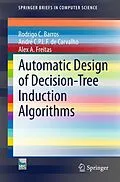Presents a detailed study of the major design components that constitute a top-down decision-tree induction algorithm, including aspects such as split criteria, stopping criteria, pruning and the approaches for dealing with missing values. Whereas the strategy still employed nowadays is to use a 'generic' decision-tree induction algorithm regardless of the data, the authors argue on the benefits that a bias-fitting strategy could bring to decision-tree induction, in which the ultimate goal is the automatic generation of a decision-tree induction algorithm tailored to the application domain of interest. For such, they discuss how one can effectively discover the most suitable set of components of decision-tree induction algorithms to deal with a wide variety of applications through the paradigm of evolutionary computation, following the emergence of a novel field called hyper-heuristics.
"Automatic Design of Decision-Tree Induction Algorithms" would be highly useful for machine learning and evolutionary computation students and researchers alike.
Inhalt
Introduction.- Decision-Tree Induction.- Evolutionary Algorithms and Hyper-Heuristics.- HEAD-DT: Automatic Design of Decision-Tree Algorithms.- HEAD-DT: Experimental Analysis.- HEAD-DT: Fitness Function Analysis.- Conclusions.
